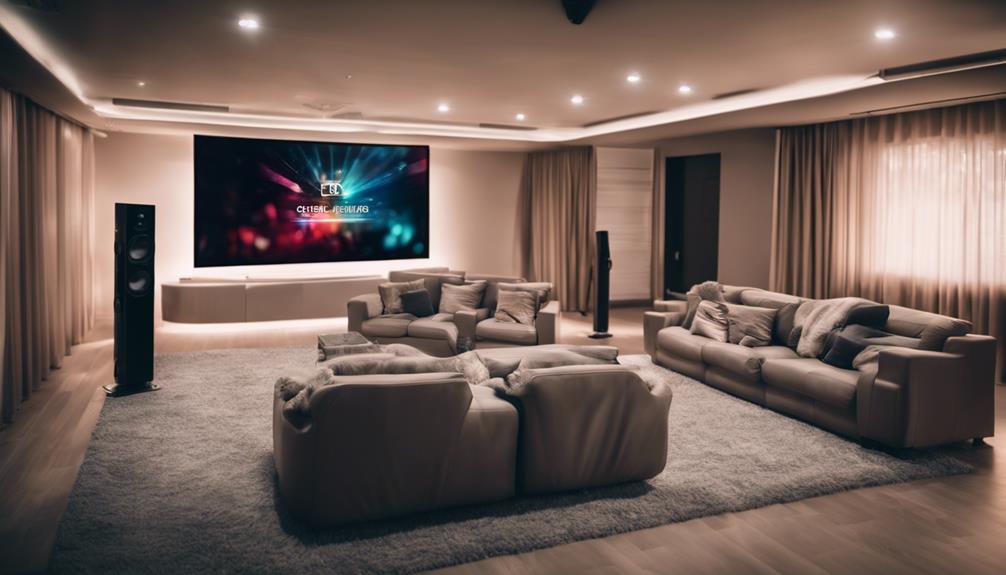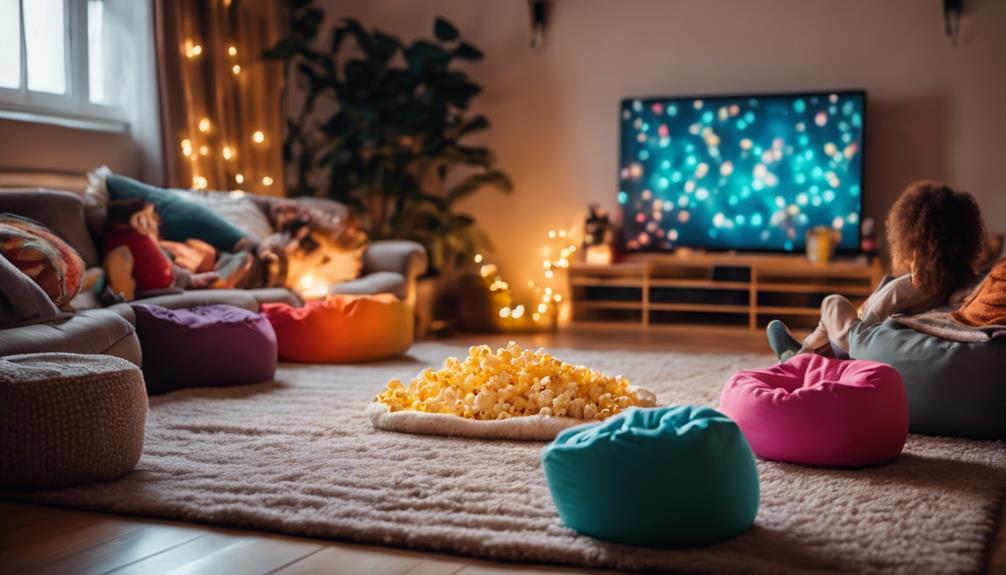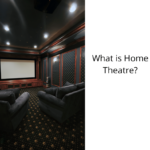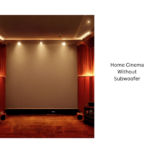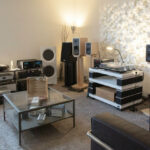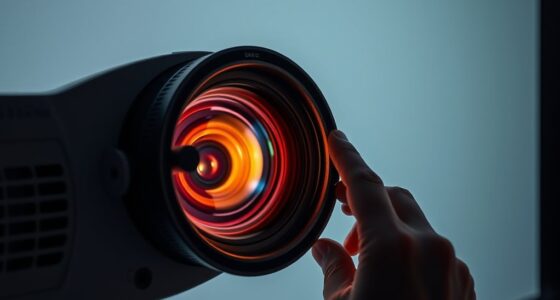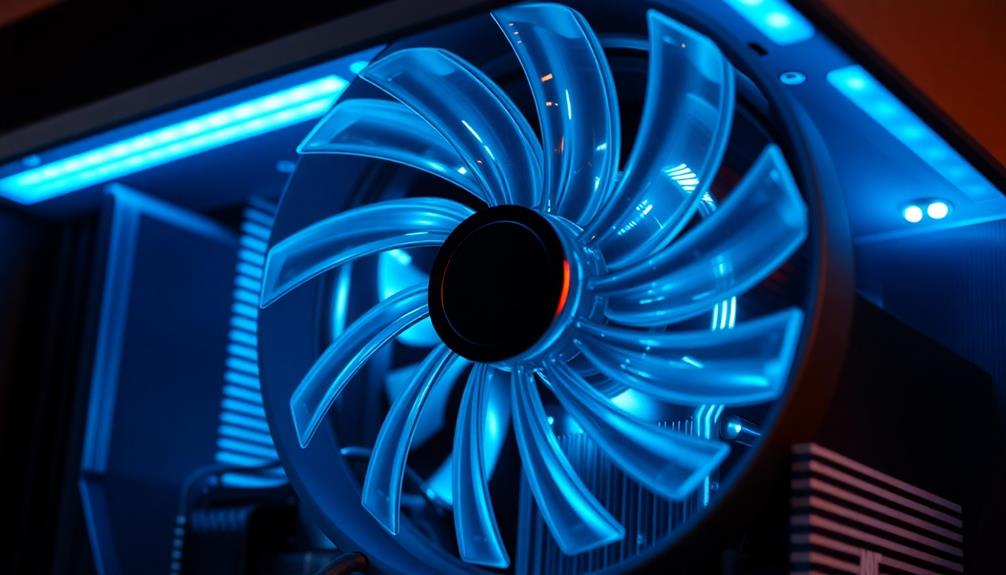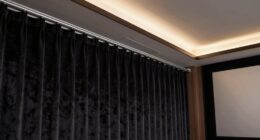Using an AV receiver enhances your home cinema experience by centrally managing audio and video signals from multiple sources. It simplifies setup with built-in amplification and supports surround sound formats like Dolby Atmos for a true cinematic feel. You can easily switch between devices without mess, maintaining high-quality audio and video. Additionally, AV receivers often come with room correction technology, optimizing sound based on your unique space. They integrate seamlessly with smart home systems, allowing convenient control of your entertainment environment. Discovering the full range of benefits can truly elevate your home theatre setup, so keep exploring!
Key Takeaways
- AV receivers centralize audio and video management, simplifying the setup of home cinema systems with multiple devices.
- They enhance sound quality with support for advanced surround sound formats like Dolby Atmos, creating a more immersive experience.
- Built-in room calibration technology optimizes audio settings based on unique acoustics for clearer and balanced sound.
- Multi-source connectivity allows seamless switching between devices, reducing cable clutter while maintaining high-quality transmission.
What Is an AV Receiver?
An AV receiver serves as the central hub in your home theater system, managing all your audio and video signals for a seamless entertainment experience. It connects multiple sources like Blu-ray players, gaming consoles, and streaming devices, ensuring you can easily switch between them.
With built-in amplifiers, an AV receiver powers your speakers, delivering rich sound and supporting advanced surround sound systems like Dolby Atmos and DTS:X, which enhance your audio experience.
Moreover, AV receivers boast impressive video processing capabilities. They allow for smooth shifts between various video sources and often include upscaling features, improving the quality of lower-resolution content. This means you can enjoy all of your favorite movies and shows in stunning clarity.
In today's digital age, many AV receivers come with built-in streaming options and internet connectivity. This functionality lets you access popular streaming services directly, reducing the need for additional devices.
With an AV receiver, you're not just simplifying your setup; you're elevating your home cinema experience, creating an immersive environment that brings every detail to life.
Key Functions of AV Receivers
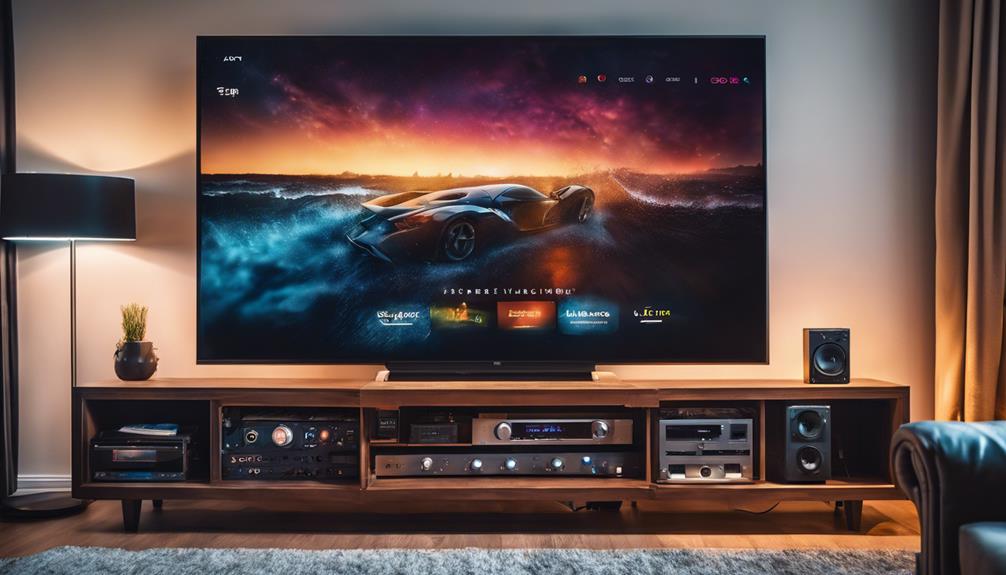
AV receivers perform several key functions that enhance your home cinema experience, from managing audio and video signals to providing seamless connectivity for all your devices.
Acting as the central hub of your home theatre system, AV receivers process audio signals from various sources like Blu-ray players and gaming consoles. You'll appreciate the built-in amplifiers that power your speakers, simplifying your setup by removing the need for separate amplification.
With support for various surround sound formats, including Dolby Atmos and DTS:X, you'll enjoy immersive audio experiences in configurations like 5.1 or 7.1. This capability elevates your movie nights and gaming sessions to new heights, making you feel right in the middle of the action.
Moreover, AV receivers come equipped with multiple HDMI inputs, making it easy to switch between devices without hassle.
If you love streaming services, many modern receivers offer internet connectivity, allowing you to access your favorite music and videos directly through the receiver.
These key functions of AV receivers make them indispensable for achieving a high-quality home cinema experience.
Differences Between Receivers and Amplifiers

Often overlooked, the distinctions between receivers and amplifiers play an essential role in shaping your home audio system.
An AV receiver combines multiple functions such as amplification, preamplification, and input switching, making it a versatile choice for your setup. In contrast, amplifiers focus solely on boosting audio signals, meaning they lack the additional processing features that a receiver offers.
When you use an AV receiver, you're equipped with built-in tuners for radio signals and support for various audio decoding formats. Power amplifiers, however, are designed specifically for driving speakers and don't include these capabilities. This makes receivers a more thorough option for managing your stereo system.
In high-end audio setups, some enthusiasts opt for separate power amplifiers alongside AV receivers. This combination can lead to cleaner audio output and greater control over sound quality.
Understanding these differences is essential as you plan an audio system tailored to your specific needs, ensuring you get the best performance and sound quality from your equipment. With the right choice, you can elevate your home cinema experience greatly.
Why You Need an AV Receiver

You need an AV receiver because it centralizes all your audio and video sources, making it easy to manage your home cinema setup.
It enhances your surround sound experience, letting you enjoy movies and music like never before.
Plus, with streamlined connections, you can reduce clutter and focus on what really matters—immersive entertainment.
Centralized Audio Management
A centralized audio management system simplifies your home cinema experience by allowing seamless switching between various devices like Blu-ray players and gaming consoles. With an AV receiver as the hub, you can effortlessly manage all your audio signals to drive your speakers without the hassle of multiple remotes.
| Feature | Benefit | Importance |
|---|---|---|
| AV Receiver | Central control for audio and video inputs | Streamlines your entire setup |
| HDMI Switching | Connect multiple devices with ease | Reduces cable clutter |
| Room Calibration Technology | Optimizes sound based on room acoustics | Enhances your overall audio experience |
| Surround Sound Receiver | Delivers immersive sound formats | Elevates your movie-watching experience |
Enhanced Surround Sound Experience
Experiencing true cinematic sound at home requires an AV receiver, as it enables advanced multi-channel audio configurations that bring movies and games to life.
With options like 5.1 and 7.1 surround sound systems, you can immerse yourself in the action like never before.
AV receivers support cutting-edge formats such as Dolby Atmos and DTS:X, delivering object-based surround sound that allows you to perceive audio from all directions, even overhead.
These devices come equipped with built-in decoders for various surround sound formats, ensuring seamless integration and playback of high-fidelity sound from Blu-ray discs, streaming services, and gaming consoles.
Plus, the room calibration technology in modern AV receivers optimizes sound based on your unique room acoustics, providing clear and balanced audio that enhances your overall viewing experience.
Benefits of Multi-Source Connectivity

Multi-source connectivity in AV receivers simplifies your home cinema experience by allowing seamless switching between devices like Blu-ray players, gaming consoles, and streaming services. Instead of constantly plugging and unplugging devices, you can connect multiple sources through various ports, including HDMI, optical, and RCA. This convenience means you can easily enjoy your favorite movies, games, or shows without interruption.
Modern AV receivers come equipped with advanced features like HDMI switching, which makes it easy to connect all your devices with a single cable running to your TV. This reduces cable clutter while ensuring you maintain high-quality audio and video transmission. Additionally, these receivers support high-definition content and immersive surround sound formats, such as Dolby Atmos and DTS:X, from different sources.
With multi-source connectivity, you're not only enjoying a streamlined setup, but you're also maximizing the potential of your home cinema.
Plus, many AV receivers offer multi-room audio capabilities, allowing you to distribute sound from various sources throughout your home. This means you can create customized listening experiences in different rooms, enhancing your overall entertainment enjoyment.
Enhancing Audio Quality
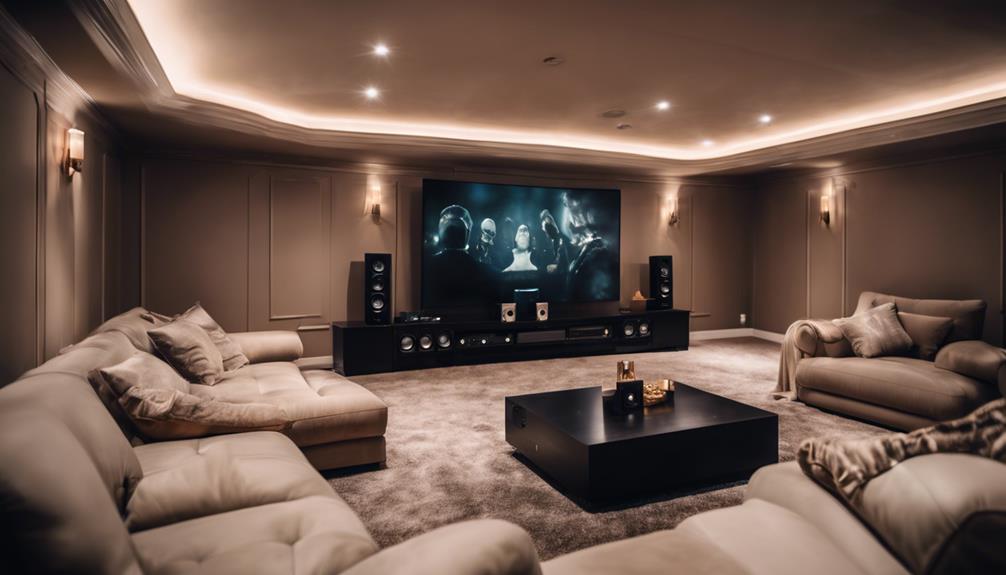
Often overlooked, enhancing audio quality is a crucial aspect of creating an immersive home cinema experience. An AV receiver greatly upgrades your sound quality, bringing your movies and games to life. With support for formats like Dolby Atmos, you'll enjoy multi-dimensional audio that fully envelops you.
| Feature | Benefits |
|---|---|
| Surround System | Realistic soundstage with 5.1 or 7.1 setups |
| Integrated Amplifier | Drives speakers effectively, minimizing distortion |
| Room Correction Tech | Optimizes audio for your space, ensuring clarity |
| Multi-Subwoofer Support | Improved bass management for a richer experience |
| High-Definition Formats | Decodes formats like DTS:X for enhanced immersion |
Integration With Smart Home Systems
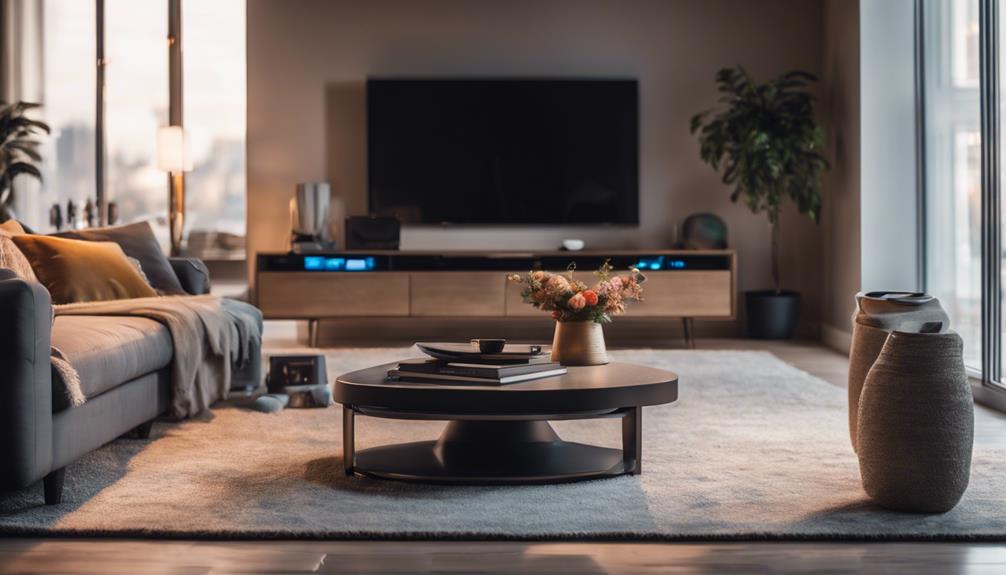
Integrating your AV receiver with smart home systems brings a whole new level of convenience to your home cinema.
You can control everything from audio and video to lighting all in one place, making your movie nights effortless.
Plus, compatibility with smart devices means you can easily set up voice commands for hands-free operation.
Smart Device Compatibility
Modern AV receivers seamlessly connect with smart home systems, letting you control your entertainment setup with voice commands and automate your experience effortlessly.
With built-in compatibility for popular platforms like Amazon Alexa and Google Assistant, you can easily adjust volume, switch inputs, or even play your favorite streaming services just by speaking.
The HDMI-CEC feature enhances this convenience, allowing you to control multiple HDMI-connected devices with a single remote, reducing clutter and simplifying your setup.
Want to listen to music throughout your home? Many receivers support Multiroom Audio, enabling you to play different audio in various rooms or the same playlist everywhere.
Regular firmware updates guarantee your AV receiver stays current with the latest technology trends, often introducing new smart home integrations that enhance functionality.
Plus, the ability to connect to Wi-Fi networks means you can stream music from platforms like Spotify and Apple Music directly through your receiver, enriching your listening experience.
Centralized Control Options
Centralized control options let you manage your entire audio and video setup effortlessly through a single interface or mobile app, enhancing your home cinema experience.
With an AV receiver integrated into your smart home systems, you can easily control all your audio and video components, making it simple to switch between devices or adjust settings without hassle.
Many modern AV receivers come equipped with voice control features, allowing you to operate your home cinema hands-free through popular smart assistants like Amazon Alexa or Google Assistant. This means you can play your favorite streaming services or adjust the volume just by speaking a command.
Advanced connectivity options, like Wi-Fi and Ethernet, enable seamless streaming from various online services, ensuring you have access to a wide range of content. Plus, integrating your AV receiver with your smart home ecosystem lets you create automated routines. You can set up scenes that adjust lighting, sound, and video with a single command, transforming your space into the perfect environment for movie nights or gaming sessions.
With room calibration technology, AV receivers can even optimize sound quality based on your specific room acoustics, making every viewing more immersive.
Room Correction Technology Advantages

Room correction technology frequently enhances your home cinema experience by analyzing and adjusting audio output to suit your room's unique acoustic properties. Systems like Audyssey and Dirac Live use microphones to measure sound at various listening positions, allowing for precise calibration that optimizes sound quality. This means you get high-quality sound without needing extensive acoustic treatments.
Here's how room correction technology can benefit you:
| Advantages | Details |
|---|---|
| Improves Clarity | Balances frequencies for clearer sound reproduction. |
| Enhances Spatial Imaging | Creates a more immersive audio playback experience. |
| Simplifies Setup | Automatically adjusts settings without complex configurations. |
Popular AV Receiver Brands

When choosing an AV receiver, knowing the popular brands can really help you make an informed decision.
Each brand, like Denon, Yamaha, and Marantz, offers unique features that cater to different needs and budgets.
Let's compare these key options and discuss some setup tips to get you started.
Leading Brands Overview
Several leading brands dominate the AV receiver market, each offering unique features and quality to enhance your home cinema experience. When selecting the right receiver, it is crucial to evaluate options from top manufacturers like Denon, Yamaha, Onkyo, Marantz, and Sony. Here's a quick overview:
| Brand | Key Features |
|---|---|
| Denon | High-quality sound, user-friendly interfaces |
| Yamaha | Versatile models, great for various setups |
| Onkyo | Affordable options with solid performance |
| Marantz | Superior audio fidelity, ideal for audiophiles |
| Sony | Budget-friendly, reliable for home theatre systems |
Denon impresses with models like the AVR-S670H, rated 5 stars at $439. Yamaha's RX-V385, rated at 4.5 stars for around $349.95, offers versatility. Onkyo stands out for affordability with the TX-NR6100 and TX-RZ50, both rated at 4.5 stars. Marantz appeals to those seeking high-end audio, while Sony provides budget-friendly receivers perfect for home theatre systems. These options guarantee you can find an AV receiver tailored to your cinema needs.
Key Features Comparison
Comparing key features across popular AV receiver brands reveals essential differences that can greatly enhance your home cinema experience.
For instance, the Denon AVR-S670H supports 8K video and advanced sound formats like Dolby Atmos, making it a versatile home theater receiver for movie buffs.
If you're looking for affordability, the Yamaha RX-V385 offers multiple HDMI inputs and YPAO room calibration technology to optimize sound quality based on your room's acoustics, all at a budget-friendly price.
On the other hand, the Onkyo TX-NR6100 features built-in streaming options and 4K/120Hz passthrough, perfect for gamers seeking enhanced multimedia experiences.
For those just starting with a home theater setup, the Sony STR-DH590 is known for its straightforward setup and solid performance in 5.1 channel configurations, making it an ideal entry-level choice.
Installation and Setup Tips
To get the most out of your AV receiver, follow these installation and setup tips to guarantee a seamless experience with your home cinema system.
Start by choosing a well-ventilated area for installation, as placing your AV receiver in an enclosed space can cause overheating, impacting performance. When connecting devices, opt for high-quality HDMI cables; they greatly reduce signal loss and enhance audio and video quality.
Next, pay attention to speaker placement. Position your speakers at ear level and create an even surround sound experience by ensuring they're equidistant from your main seating area.
Most modern AV receivers come with room calibration technology like Audyssey or Dirac. Use this feature to automatically adjust settings based on your room's acoustics, delivering ideal sound quality tailored to your space.
Installation Tips for AV Receivers

How can you guarantee your AV receiver delivers the best performance? Start by placing your AV receiver in a well-ventilated area to prevent overheating during those long movie marathons.
Use high-quality HDMI cables for all your video and audio connections; this maximizes signal integrity and reduces interference.
Next, pay close attention to speaker placement. Ideally, front speakers should be at ear level, while subwoofers should be positioned to enhance bass response. Following manufacturer guidelines will help achieve the best sound in your home cinema.
Don't forget about room calibration! Many modern AV receivers come equipped with technology that automatically adjusts settings based on your room's acoustics, greatly improving sound quality.
Lastly, keep your AV receiver updated. Regularly check for firmware updates from the manufacturer to guarantee compatibility with new technologies and enhance overall system performance.
Frequently Asked Questions
What Are the Benefits of AV Receiver?
AV receivers simplify your audio and video setup, enhance sound quality, and save space. They decode advanced formats, offer room calibration, and let you enjoy multi-room audio, making your entertainment experience more immersive and convenient.
Why Do I Need a Receiver for Home Theater?
Imagine traversing a busy street without a map. You need a receiver for your home theater to streamline connections, enhance sound quality, and simplify device switching, ensuring you enjoy a seamless, immersive entertainment experience.
Does a Good AV Receiver Make a Difference?
Absolutely, a good AV receiver makes a significant difference. You'll notice enhanced audio quality, clearer sound, and immersive surround effects. It transforms your viewing experience, making every movie and show feel more dynamic and engaging.
Does an AV Receiver Improve Picture Quality?
Yes, an AV receiver can improve picture quality. It processes video signals, upscales content, and supports HDR, enhancing clarity and color. With proper calibration, it optimizes output for your display, ensuring a better viewing experience.
Conclusion
Incorporating an AV receiver into your home cinema not only enhances your audio-visual experience but also simplifies your entertainment setup.
For instance, imagine hosting a movie night where you seamlessly switch between a Blu-ray player and a gaming console, all while enjoying rich, immersive sound.
By investing in an AV receiver, you're ensuring flexibility and superior quality, making every movie marathon or gaming session unforgettable.
It's a game-changer for any home entertainment enthusiast.
